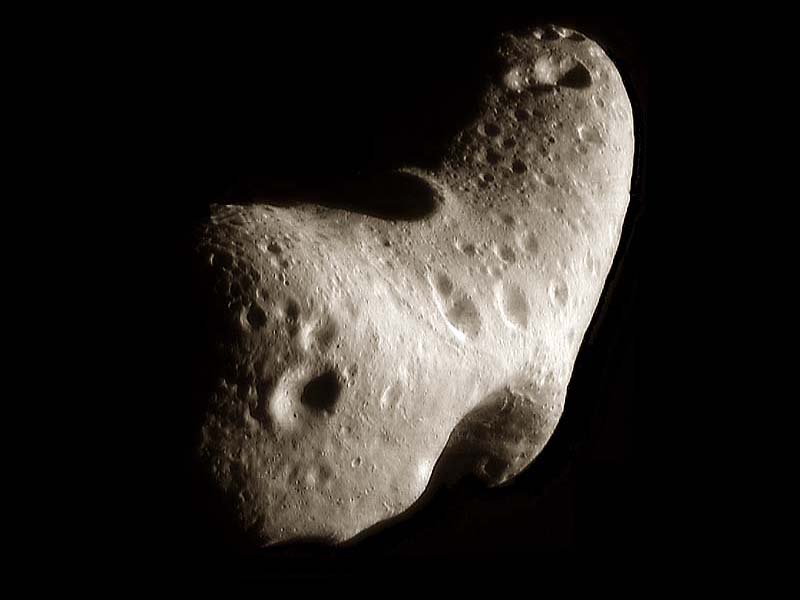

Presuming Planetary Resources builds a fleet of prospecting space telescopes, locates mineral-bearing space rocks, gets to them and successfully mines them, then what? Can a corporation lay claim to these protoplanetary leftovers, and can they really sell them? Or are they part of our common celestial heritage, priceless pieces of early creation that should be protected?
For a lot of reasons, the legal ramifications of today’s asteroid mining announcement are almost as complex as the technological ones.
“As far as law is concerned, there’s nothing inherently in the space treaties that prohibits this [mining],” said Henry Hertzfeld, a research professor at the Space Policy Institute at George Washington University and an associate professor of space law. “But there are a heck of a lot of unanswered questions.”
First of all, there’s an important distinction between ownership of land or property and ownership of resources. It’s the difference between owning the oceans, which you can’t, and owning the fish that you take out of them, which you can. For now, it sounds like Planetary Resources is operating under the latter scenario, and is not laying claim to real estate or seeking property rights on the asteroids it seeks to mine.
“The United States went to the moon, took hundreds of kilograms of moon rocks, and the U.S. owns those moon rocks,” noted Art Dula, an attorney in Texas who teaches a space law course at the University of Houston law school. “The taking of minerals does not require a claim of sovereignty.”
At the heart of the space asset ownership debate is the 1967 Outer Space Treaty, a Cold War relic that prohibits establishment of colonies or sovereign rights on the moon or other celestial bodies. Private companies are not necessarily prohibited from establishing settlements, but the treaty also holds that states oversee and regulate these putative companies and their activities, and assume liability for any bad scenarios. (Speaking of which: We’re still waiting to hear more about the safety aspects of this new plan, because slurping up or mining an asteroid would conceivably affect its orbital trajectory…. and that could be bad.)
This liability factor, as well as Federal Aviation Administration licensing requirements and safety concerns, will be at issue as Planetary Resources develops its plans, Dula and Hertzfeld said. To Hertzfeld, the company’s potential public partnerships — with NASA or other agencies — could be key. Space visionary and entrepreneur Peter Diamandis, co-founder and co-chairman as well as founder of the X Prize competition, said Tuesday the company will serve the public as well as private enterprise, which Hertzfeld noted with interest.
“If you can convince the government that there is a public mission, a public purpose, in doing a project of this sort, and be your partner, this is business as usual,” Hertzfeld said. “If the government is going up, it doesn’t need a license. It supervises itself, and assumes certain liabilities and risks.”
Some space colonization advocates argue that guaranteeing ownership of celestial real estate is a necessary precursor to developing that real estate. Just last month, the Competitive Enterprise Institute, a libertarian think tank, proposed that the U.S. recognize off-planet property rights to spur space development. But Hertzfeld calls this a red herring.
“How many companies own the land their buildings are on? A lot of them lease it, and behind that is a government guarantee that says this lease is valid,” Hertzfeld said. “We can do something like that in space. … Whether it’s a UN system, a bilateral or multilateral agreement, that doesn’t matter as long as the investors know they can maintain their return on investment. That’s all that counts. The ownership of land is secondary.”
Dula, who spoke with PopSci before giving a lecture on asteroid mining at the law school, also said resource ownership is clearly allowed. “If you risked your life and treasure to go into space and obtain rocks or minerals, there’s no reason they wouldn’t belong to you, just like the Apollo samples belong to the United States,” he said.
As of now, the U.S. is the only entity to bring space objects home that would be of any value. The Japanese last year retrieved some space dust from the Hayabusa asteroid lander, but its value was purely scientific, not commercial. Bringing home loads of platinum, water or any other resource would be a different story, and there’s no jurisprudence on that yet.
Regarding property rights, the case of Gregory W. Nemitz and the Eros Project offers some perspective. Nemitz claimed ownership of asteroid 433 Eros, one of the largest asteroids in a near-Earth orbit and one with abundant supplies of aluminum, iron, potassium and magnesium, among other metals. The Eros Project seeks to establish a mining colony on the asteroid and develop these materials, according to its website. In 2000-2001, NASA’s NEAR Shoemaker spacecraft orbited the asteroid and eventually landed on its surface. Nemitz sued NASA for parking fees. His case was dismissed, but NASA’s arguments and reference to the Outer Space Treaty notes that space and space objects are “not subject to national appropriation.”
As long as Planetary Resources doesn’t try to claim ownership of the asteroids it mines, this argument may not arise. But it’s not a far leap to imagine what the company will do if competitors try to jump its mining claims.
Both legal experts said the law is still immature, and would continue to develop as Planetary Resources moves forward and forms more specific plans.
“We need to know what the ‘it’ is first, and we don’t,” Hertzfeld said. “Their near-term plans are sort of standard space exploration stuff, science stuff. It’s what happens after that, and what they actually want to do.”
